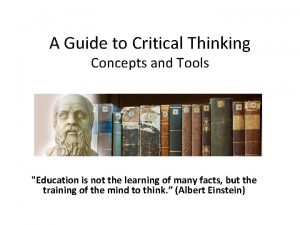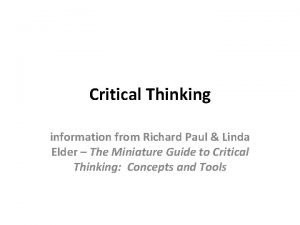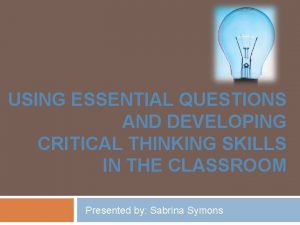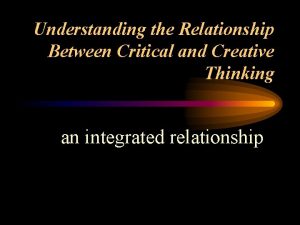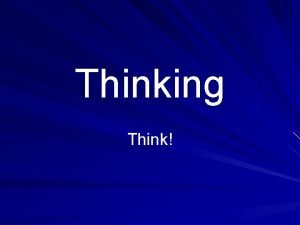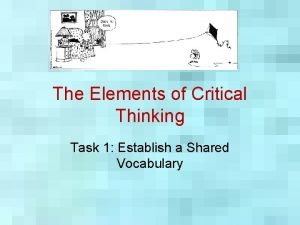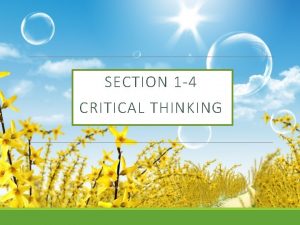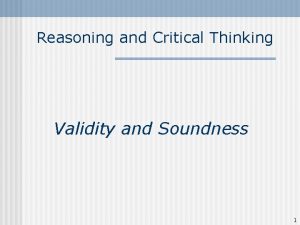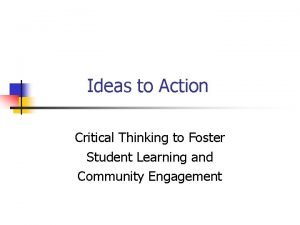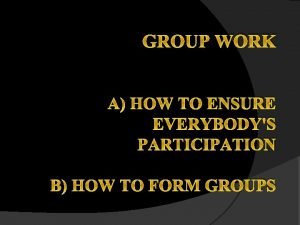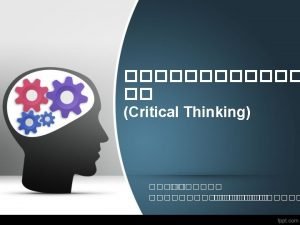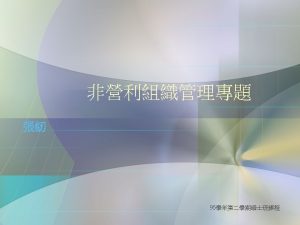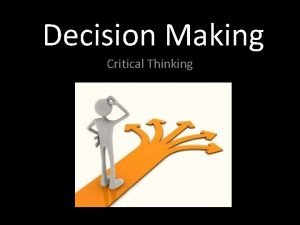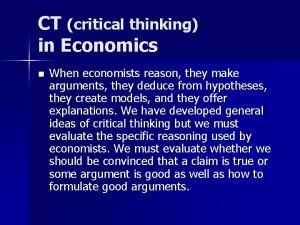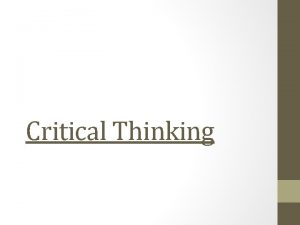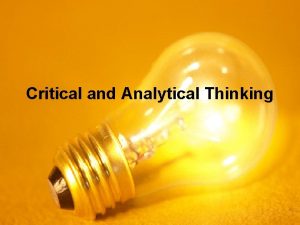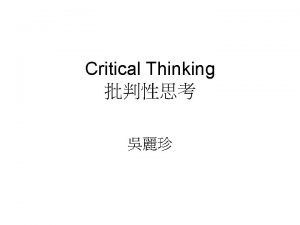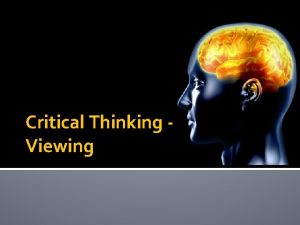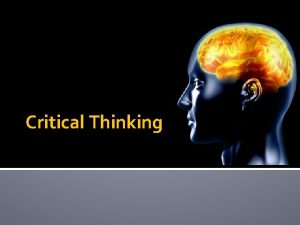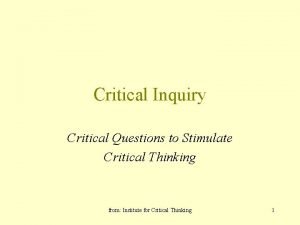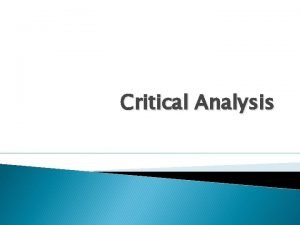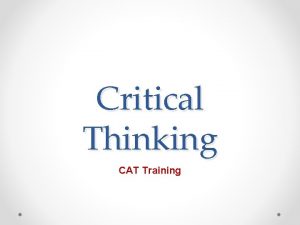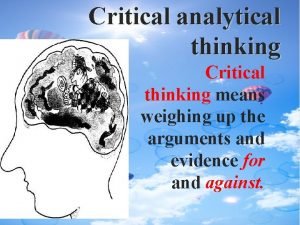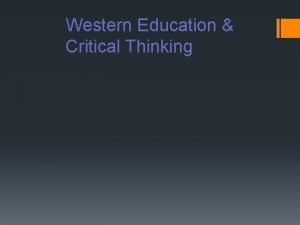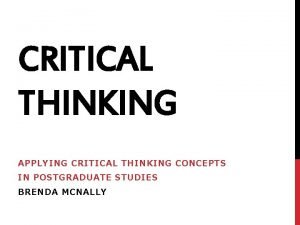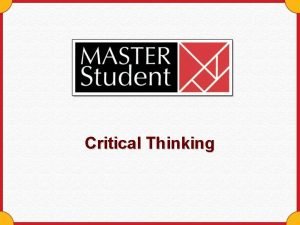Teaching Critical Thinking through DanceMaking The Thinking Tools



























- Slides: 27

Teaching Critical Thinking through Dance-Making

The Thinking Tools Sparks of Genius: The 13 Thinking Tools of the World’s Most Creative People • Based on the book • By Robert & Michele Root- Bernstein • Published by Houghton Mifflin in 1999

The Thinking Tools to Be Discussed Include. . . • Observing • Transforming • Recognizing • Abstracting patterns • Empathizing • Body Thinking • Imaging • Playing • Forming patterns • Modeling • Synthesizing

Selected & arranged in this way because. . . • They can be easily applied to the creative process in movement & dance. • This order of arrangement follows the order of operations in dance-making.

Creative Movement Dance-Making Process • Inspiration • Observing inspiration • Responding to inspiration • Felt-thoughts + Imagination • Transforming & abstracting = • Movement + • Playing around = • Final product or dance

Observing • Means active observation • Making sense of the sensation • Learning to see in new & different ways • Seeing details such as colors, separate parts of picture or foreground & background

What details can you observe in this picture?

Recognizing Patterns • Noticing relationships • Using various viewpoints to reveal different patterns • Patterns recognized can be visual, auditory, tactile, kinesthetic • Culture influences pattern recognition

What patterns do you see in this picture?

Empathizing • Being able to see the world through the eyes of others • Having personal knowledge • Becoming the animal, plant or object • Imagine what the object of your attention is sensing

What feelings do you get from the two photos below?

Body Thinking • Usually hidden from us • Using movement to solve problems • Felt-thought • A heightened physical awareness • Kinesthetic empathy

How would your body feel in each of the two positions below?

Imaging • Seeing pictures in the mind or • • • visualizing Thinking about sounds Being able to recall a body feeling Seeing movements in the mind Being polysensual—synesthesia A virtual experience

What mental images can you create from the two cut paper designs below?

Transforming • Changing from one sense to another • Using diverse methods to solve a problem • A blurring of lines between fields • Transformations are not always exactly equivalent

Transforming body shapes. . .

Abstracting • Begins with the real • Representing the essence of • The core • A simplification of • A tool for artists • Can be interactive across disciplines (visual arts & high speed photography)

An abstraction of a forest. . .

Playing • Experimenting • Fooling around • Treating work like a game • Breaking the rules & testing limits • Encouraging the unexpected • Limited sloppiness • Invoking a make believe world

Playing around with a photo

Forming Patterns • Combining structural elements or • • operations Can be spontaneous or planned Spans sensory modalities & disciplines Embodies relationships & meanings Leads to innovations

Forming a Pattern. . .

Modeling • Simulations • A physical representation of • Helps teach imaginative skills • Capturing the essence of operations • Embodying concepts • Supplies control of situation • Reveals problems

Models of Dances - floor patterns for 2 dancers (L) & changes in energy quality (R)

Synthesizing • Bringing together sensory • • impressions, feelings, knowledge & memories Creating unity & wholes An integration of the thinking tools Trans disciplinary & multimodal A necessity in solving problems

A whole dance is the result of synthesizing.
 Critical semi critical and non critical instruments
Critical semi critical and non critical instruments Principle of sterilization
Principle of sterilization Well cultivated critical thinker
Well cultivated critical thinker Linda elder critical thinking
Linda elder critical thinking Perbedaan critical thinking dan creative thinking
Perbedaan critical thinking dan creative thinking Compare non-critical readers with critical readers.
Compare non-critical readers with critical readers. Micro teaching meaning
Micro teaching meaning Pert chart expert
Pert chart expert Which is the hardest
Which is the hardest Critical thinking guidelines
Critical thinking guidelines Critical thinking examples
Critical thinking examples Relationship between creative and critical thinking
Relationship between creative and critical thinking Critical thinking examples in real life
Critical thinking examples in real life Nosich elements of critical thinking
Nosich elements of critical thinking The cask of amontillado literary analysis answers
The cask of amontillado literary analysis answers Critical thinking examples
Critical thinking examples False premise example
False premise example Active learning strategies to promote critical thinking
Active learning strategies to promote critical thinking Levels of critical thinking in nursing
Levels of critical thinking in nursing 5 components of critical thinking
5 components of critical thinking Critical thinking icebreakers
Critical thinking icebreakers Critical thinking in group work
Critical thinking in group work Fahrenheit 451 part 2 discussion questions
Fahrenheit 451 part 2 discussion questions Critical thinking definition
Critical thinking definition Critical thinking wikipedia
Critical thinking wikipedia One case of dehydrated milk
One case of dehydrated milk Example of objective claim
Example of objective claim Critical thinking cheat sheet
Critical thinking cheat sheet


